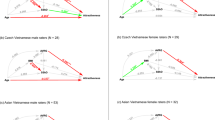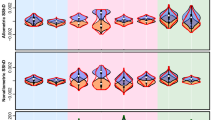Abstract
The theory of sexual selection suggests several possible explanations for the development of standards of physical attractiveness in humans. Asymmetry and departures from average proportions may be markers of the breakdown of developmental stability. Supernormal traits may present age- and sex-typical features in exaggerated form. Evidence from social psychology suggests that both average proportions and (in females) “neotenous” facial traits are indeed more attractive. Using facial photographs from three populations (United States, Brazil, Paraguayan Indians), rated by members of the same three populations, plus Russians and Venezuelan Indians, we show that age, average features, and (in females) feminine/neotenous features all play a role in facial attractiveness.
Similar content being viewed by others
References
Alley, T. R., and M. R. Cunningham 1991 Averaged Faces Are Attractive, But Very Attractive Faces Are Not Average.Psychological Science 2:123–125.
Behrents, R. G. 1985Growth in the Aging Craniofacial Skeleton. Center for Human Growth and Development, The University of Michigan, Ann Arbor.
Benson, P., and D. Perrett 1992 Face to Face with the Perfect Image.New Scientist 133:32–35.
Brink, P. J. 1989 The Fattening Room among the Annang of Nigeria.Medical Anthropology 12:131–143.
Brown, P. J. 1992 The Biocultural Evolution of Obesity: An Anthropological View. InObesity, P. Bjorntorp and B. N. Brodoff, eds. Pp. 320–329. Philadelphia: J. B. Lippincott.
Buss, D. M. 1989 Sex Differences in Human Mate Preferences: Evolutionary Hypotheses Tested in 37 Cultures.Behavioral and Brain Sciences 12:1–49.
Cronin, H. 1991The Ant and the Peacock: Altruism and Natural Selection from Darwin to Today. New York: Cambridge University Press.
Cunningham, M. R. 1986 Measuring the Physical in Physical Attractiveness: Quasi-experiments in the Sociobiology of Female Facial Beauty.Journal of Personality and Social Psychology 50:925–935.
Darwin, C. 1981The Descent of Man and Selection in Relation to Sex. Princeton, New Jersey: Princeton University Press. (Originally published in 1871)
Deutsch, C. K. 1987 Disproportion in Psychiatric Syndromes. InAnthropometric Facial Proportions in Medicine, L. G. Farkas and I. R. Munro, eds. Pp. 131–141. Springfield, Illinois: Thomas.
Ellis, H. 1942Studies in the Psychology of Sex. New York: Random House.
Enlow, D. H. 1990Facial Growth. Philadelphia: Harcourt Brace Jovanovich.
Enquist, M., and A. Arak 1993 Selection of Exaggerated Male Traits by Female Aesthetic Senses.Nature 361:446–448.
Farkas, L. G., and I. R. Munro, eds. 1987Anthropometric Facial Proportions in Medicine. Springfield, Illinois: Thomas.
Ford, C. S., and F. Beach 1951Patterns of Sexual Behavior. New York: Harper.
Franklin, J. H., ed. 1968Color and Race. Boston: Houghton Mifflin.
Garn, S. M., M. LaVelle, and H. Smith 1985 Quantification of Dysmorphogenesis: Pattern Variability Index, σz.American Journal of Roentgenology 144:365–369.
Hatfield, E. 1986Mirror, Mirror: The Importance of Looks in Everyday Life. Albany, New York: State University of New York Press.
Hoetink, H. 1967The Two Variants in Caribbean Race Relations: A Contribution to the Sociology of Segmented Societies. London: Oxford University Press.
Koeslag, J. 1990 Koinophilia Groups Sexual Creatures into Species, Promotes Stasis, and Stabilizes Social Behavior.Journal of Theoretical Biology (144):15–35.
Langlois, J. H., and L. A. Roggman 1990 Attractive Faces Are Only Average.Psychological Science 1:115–121.
Langlois, J., L. A. Roggman, and J. M. Ritter 1987 Infant Preferences for Attractive Faces: Rudiments of a Stereotype?Developmental Psychology 23:363–369.
Lele, S., and J. T. Richtsmeier 1991 Euclidean Distance Matrix Analysis: A Coordinate-Free Approach for Comparing Biological Shapes Using Landmark Data.American Journal of Physical Anthropology 86:415–427.
Livshits, G., and E. Kobylianski 1991 Fluctuating Asymmetry as a Possible Measure of Developmental Homeostasis in Humans: A Review.Human Biology 63:441–466.
McArthur, L. Z., and D. S. Berry 1983 Impressions of Baby-faced Adults.Social Cognition 2:315–342.
Møller, A. P. 1990 Fluctuating Asymmetry in Male Ornaments May Reliably Reveal Male Quality.Animal Behaviour 40:1185–1187.
Møller, A. P., and J. Höglund 1991 Patterns of Fluctuating Asymmetry in Avian Feather Ornaments: Implications for Models of Sexual Selection.Proceedings of the Royal Society of London. B 245:1–5.
Parsons, P. A. 1990 Fluctuating Asymmetry: An Epigenetic Measure of Stress.Biological Reviews 65:131–145.
Polhemus, T. 1988Body Styles. Luton, Bedfordshire: Lennard.
Riedl, B. I. M. 1990 Morphologisch-metrische Merkmale des Männlichen und Weiblichen Partnerleitbildes in Ihrer Bedeutung für die Wahl des Ehegatten.Homo 41:72–85.
Russell, K., M. Wilson, and R. Hall 1992The Color Complex: The Politics of Skin Color among African-Americans. New York: Harcourt Brace Jovanovich.
Ryan, M. J., J. H. Fox, W. Wilczynski, and A. S. Rand 1990 Sexual Selection by Sensory Exploitation in the FrogPhysalaemus pustulosis.Nature 343:66–67.
Staddon, J. E. R. 1975 A Note on the Evolutionary Significance of “Supernormal Stimuli.”American Naturalist 109:541–545.
Strzałko, J., and K. A. Kaszycka 1992 Physical Attractiveness: Interpersonal and Intrapersonal Variability of Assessments.Social Biology 39:170–176.
Symons, D. 1979The Evolution of Human Sexuality. New York: Oxford University Press.
ten Cate, C., and P. Bateson 1989 Sexual Imprinting and a Preference for “Supernormal” Partners in Japanese Quail.Animal Behaviour 38:356–358.
Thornhill, R. 1992 Fluctuating Asymmetry and the Mating System of the Japanese Scorpionfly,Panorpa japonica.Animal Behaviour 44:867–879.
Waddington, C. H. 1957The Strategy of the Genes: A Discussion of Some Aspects of Theoretical Biology. London: Allen and Unwin.
Westermarck, E. 1891The History of Human Marriage. London and New York: Macmillan.
Williams, G. C. 1966Adaptation and Natural Selection: A Critique of Some Current Evolutionary Thought. Princeton, New Jersey: Princeton University Press.
1992Natural Selection: Domains, Levels, Challenges. Oxford: Oxford University Press.
Author information
Authors and Affiliations
Additional information
This research was supported by NSF Doctoral Dissertation Research Improvement Grant BNS-9006394 and grants from the University of Michigan’s Department of Anthropology and Evolution and Human Behavior Program.
Doug Jones is a doctoral candidate in biological anthropology at the University of Michigan. He has done fieldwork in Paraguay, Brazil, the United States, and Russia, and is currently writing his dissertation on human physical attractiveness. His research interests include sexual selection inHomo sapiens, evolutionary psychology, “dual inheritance” theories of gene-culture coevolution, and the anthropology of Brazil.
Kim Hill is an associate professor in the Human Evolutionary Ecology Program at the University of New Mexico. His primary research interests include the evolutionary ecology of human reproductive strategies, sexual division of labor, life history, and resource acquisition. He has worked among the Ache of Paraguay and Hiwi of Venezuela as well as the Machiguenga and Yora of Peru. He is currently writing a demography of the Ache foragers. Recent publications include “The Evolution of Premature Reproductive Senescence and Menopause in Human Females” with A. Magdalena Hurtado (Human Nature 2(4):313–350, 1991).
Rights and permissions
About this article
Cite this article
Jones, D., Hill, K. Criteria of facial attractiveness in five populations. Human Nature 4, 271–296 (1993). https://doi.org/10.1007/BF02692202
Received:
Accepted:
Issue Date:
DOI: https://doi.org/10.1007/BF02692202




